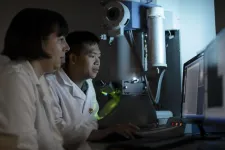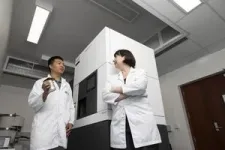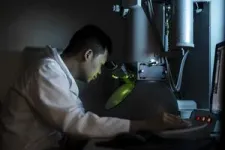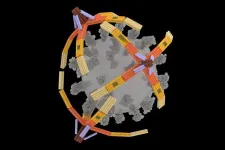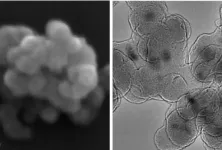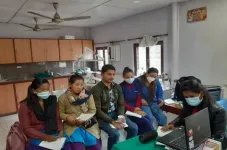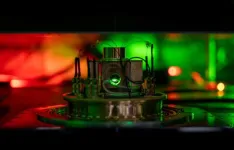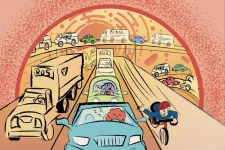(Press-News.org) Researchers at the University of Sydney Nano Institute have made a significant advance in the field of molecular robotics by developing custom-designed and programmable nanostructures using DNA origami.
This innovative approach has potential across a range of applications, from targeted drug delivery systems to responsive materials and energy-efficient optical signal processing. The method uses ‘DNA origami’, so-called as it uses the natural folding power of DNA, the building blocks of human life, to create new and useful biological structures.
As a proof-of-concept, the researchers made more than 50 nanoscale objects, including a ‘nano-dinosaur’, a ‘dancing robot’ and a mini-Australia that is 150 nanometres wide, a thousand times narrower than a human hair.
The research is published today in the pre-eminent robotics journal Science Robotics.
The research, led by first author Dr Minh Tri Luu and research team leader Dr Shelley Wickham, focuses on the creation of modular DNA origami “voxels” that can be assembled into complex three-dimensional structures. (Where a pixel is two-dimensional, a voxel is realised in 3D.)
These programmable nanostructures can be tailored for specific functions, allowing for rapid prototyping of diverse configurations. This flexibility is crucial for developing nanoscale robotic systems that can perform tasks in synthetic biology, nanomedicine and materials science.
Dr Wickham, who holds a joint position with the Schools of Chemistry and Physics in the Faculty of Science, said: “The results are a bit like using Meccano, the children’s engineering toy, or building a chain-like cat’s cradle. But instead of macroscale metal or string, we use nanoscale biology to build robots with huge potential.”
Dr Luu said: “We've created a new class of nanomaterials with adjustable properties, enabling diverse applications – from adaptive materials that change optical properties in response to the environment to autonomous nanorobots designed to seek out and destroy cancer cells.”
VELCRO DNA
To assemble the voxels, the team incorporate additional DNA strands on to the exterior of the nanostructures, with the new strands acting as programmable binding sites.
Dr Luu said: “These sites act like Velcro with different colours – designed so that only strands with matching ‘colours’ (in fact, complementary DNA sequences) can connect.”
He said this innovative approach allows precise control over how voxels bind to each other, enabling the creation of customisable, highly specific architectures.
One of the most exciting applications of this technology is its potential to create nanoscale robotic boxes capable of delivering drugs directly to targeted areas within the body. By using DNA origami, researchers can design these nanobots to respond to specific biological signals, ensuring medications are released only when and where they are needed. This targeted approach could enhance the effectiveness of cancer treatments while minimising side effects.
In addition to drug delivery, the researchers are exploring the development of new materials that can change properties in response to environmental stimuli. For instance, these materials could be engineered to be responsive to higher loads or alter their structural characteristics based on changes in temperature or acidic (pH) levels. Such responsive materials have the potential to transform medical, computing and electronics industries.
Dr Wickham said: “This work enables us to imagine a world where nanobots can get to work on a huge range of tasks, from treating the human body to building futuristic electronic devices.”
The research team is also investigating energy-efficient methods for processing optical signals, which could lead to improved image verification technologies. By harnessing the unique properties of DNA origami, these systems could improve the speed and accuracy of optical signal processing, paving the way for enhanced techniques in medical diagnostics or security.
Dr Luu, a postdoctoral researcher in the School of Chemistry, said: “Our work demonstrates the incredible potential of DNA origami to create versatile and programmable nanostructures. The ability to design and assemble these components opens new avenues for innovation in nanotechnology.”
Dr Wickham said: "This research not only highlights the capabilities of DNA nanostructures but also emphasises the importance of interdisciplinary collaboration in advancing science. We are excited to see how our findings can be applied to real-world challenges in health, materials science and energy.”
As researchers continue to refine these technologies, the potential for creating adaptive nanomachines that can operate in complex environments, such as within the human body, is becoming increasingly feasible.
-ENDS-
Download a short video of a ‘mini dinosaur’ being formed and photos of researchers at this link.
Interviews
Dr Shelley Wickham | shelley.wickham@sydney.edu.au
Dr Minh Tri Luu | m.luu@sydney.edu.au
Media enquiries
Marcus Strom | marcus.strom@sydney.edu.au | +61 474 269 459
Outside of work hours, please call +61 2 8627 0246 (this directs to a mobile number) or email media.office@sydney.edu.au.
Research
Luu, M.T. et al ‘Reconfigurable nanomaterials folded from multi-component chains of DNA origami voxels’ (Science Robotics 2024). DOI: 10.1126/scirobotics.adp2309
Declaration
The authors declare no competing interests. Research was supported by the Australian Research Council, the Westpac Research Fellowship, the University of Sydney Nano Institute, the University of Sydney Physics Foundation; the Australian Department of Industry, Science and Resources, and the Engineering and Physical Sciences Research Council (UK).
Researchers used equipment in the University of Sydney Microscopy and Microanalysis facility.
END
Researchers have quantified for the first time the global emissions of a sulfur gas produced by marine life, revealing it cools the climate more than previously thought, especially over the Southern Ocean.
The study, published in the journal Science Advances, shows that the oceans not only capture and redistribute the sun's heat, but produce gases that make particles with immediate climatic effects, for example through the brightening of clouds that reflect this heat.
It broadens the climatic impact of marine sulfur because it adds a new compound, methanethiol, that had previously gone unnoticed. Researchers only detected the gas recently, because ...
CHAMPAIGN, Ill. — A tiny, four-fingered “hand” folded from a single piece of DNA can pick up the virus that causes COVID-19 for highly sensitive rapid detection and can even block viral particles from entering cells to infect them, University of Illinois Urbana-Champaign researchers report. Dubbed the NanoGripper, the nanorobotic hand also could be programmed to interact with other viruses or to recognize cell surface markers for targeted drug delivery, such as for cancer treatment.
Led by Xing Wang, a professor of bioengineering and of chemistry at the ...
In 1992, Judith Frydman, PhD, discovered a molecular complex with an essential purpose in all of our cells: folding proteins correctly.
The complex, a type of “protein chaperone” known as TRiC, helps fold thousands of human proteins: It was later found that about 10% of all our proteins pass through its barrel structure.
All animals have several different kinds of protein chaperones, each with its own job of helping fold proteins in the cell. TRiC binds to newborn proteins and shapes these strings of amino acids into the correct 3D structures, ...
HOUSTON – (Nov. 27, 2024) – Newly developed halide perovskite nanocrystals (HPNCs) show potential as antimicrobial agents that are stable, effective and easy to produce. After almost three years, Rice University scientist Yifan Zhu and colleagues have developed a new HPNC that is effective at killing bacteria in a biofluid under visible light without experiencing light- and moisture-driven degradation common in HPNCs.
A new method using two layers of silicon dioxide that Zhu and colleagues developed over years of work was used in experiments with lead-based and bismuth-based HPNCs to test their antimicrobial efficacy and stability in water. ...
Our bodies divest themselves of 60 billion cells every day through a natural process of cell culling and turnover called apoptosis.
These cells — mainly blood and gut cells — are all replaced with new ones, but the way our bodies rid themselves of material could have profound implications for cancer therapies in a new approach developed by Stanford Medicine researchers.
They aim to use this natural method of cell death to trick cancer cells into disposing of themselves. Their method accomplishes this by artificially bringing together two proteins in such a way that the new compound switches on a set of cell death genes, ultimately driving tumor cells to turn on themselves. ...
Culturally appropriate women-centred interventions can help healthcare systems respond to domestic violence, research has found. HERA (Healthcare Responding to Violence and Abuse) has been co-developing and evaluating a domestic violence and abuse healthcare intervention in low- and middle-income countries for the past five years. This National Institute for Health and Care Research (NIHR) Global Research Group will report their findings, and publish a PolicyBristol report, at a conference in London today ...
The mission of IQST is to further our understanding of nature and develop innovative technologies based on quantum science by leveraging synergies between the natural sciences, engineering, and life sciences. "Many KIT scientists already successfully support IQST with their expertise as Fellows. All the more I am pleased that the Karlsruhe Institute of Technology is now joining our interdisciplinary centre as an institution," says IQST Director Prof. Stefanie Barz. "This will strengthen networking within the academic quantum community in Baden-Württemberg," emphasizes ...
***Embargoed until November 27 at 11 AM EST***
Chronic diseases like type 2 diabetes and inflammatory disorders have a huge impact on humanity. They are a leading cause of disease burden and deaths around the globe, are physically and economically taxing, and the number of people with such diseases is growing.
Treating chronic disease has proven difficult because there is not one simple cause, like a single gene mutation, that a treatment could target. At least, that’s how it has appeared to scientists. However, research from Whitehead Institute Member Richard Young and colleagues, published in the journal ...
About The Study: This study found a steep decline in cervical cancer mortality among U.S. women younger than 25 years between 2016 and 2021. This cohort of women is the first to be widely protected against cervical cancer by human papillomavirus (HPV) vaccines. The findings from this study in the context of other published research suggest that HPV vaccination affected the sequential decline in HPV infection prevalence, cervical cancer incidence, and cervical cancer mortality.
Corresponding ...
In an international collaboration, researchers at Uppsala University have been able to identify undigested food remains, plants and prey in the fossilised faeces of dinosaurs. These analyses of hundreds of samples provide clues about the role dinosaurs played in the ecosystem around 200 million years ago. The findings have been published in the journal Nature.
“Piecing together ‘who ate whom’ in the past is true detective work,” says Martin Qvarnström, researcher at the Department of Organismal Biology and lead author of the study. “Being able to examine what animals ate and how they interacted with their environment helps us understand what enabled ...
